Heading out the door? Read this article on the new Outside+ app available now on iOS devices for members! Download the app.
This article—and many more like it—is available exclusively to Outside+ members, along with a host of others benefits such as access to the Warren Miller Entertainment film archive (that’s 50-some films), ski-instruction and fitness video tutorials, pro deals and members-only industry discounts, and a print subscription to SKI. Learn more about Outside+ here, and find more great adventure stories from the SKI archive here.
TO GET TO THE WORLD’S MOST exotic ski resort you must first get to Pyongyang, the capital of North Korea, where, after the People’s Army checks your papers and records your smartphone’s serial number, you will end up at the Yanggakdo, one of perhaps eight hotels in this city of 2.5 million people where foreigners are allowed to stay. The hotel is grayish blue and lords over a horn-shaped island. It has 47 floors and a thousand outdated rooms. About 30 of those rooms are occupied today.
It is mid-February, the year Juche 103. The frozen Taedong River that flows around the hotel is corpse-gray, stiff, and riddled with abandoned ice-fishing holes that look like bullet wounds. Few lights burn anywhere, only a billboard flickering in the distance with images of the country’s dictator, Kim Jong-un. He’s the reason I’m here.
But first, breakfast. The elevator snaps shut with crushing authority. It’s 38 floors down from my room to Restaurant 1, which sits next to Restaurant 2, which sits next to a glass-walled gift shop that sells severed baby bear paws to cure indigestion.
At floor 35 the doors jerk open. The hallway is a coal mine. No one is there.
“Hello?” I call. No reply. The same happens again four floors later, and again three floors after that. It happens at Floor 25 and Floor 23 and Floor 19. Each time the scene is spookier than the last. No lights. No people. Only Floor 5 doesn’t open. This is because there is no button for Floor 5, and the stairwells at Floors 4 and 6 are barricaded and locked. Floor 5, I’ll later learn, holds all the bugging devices.
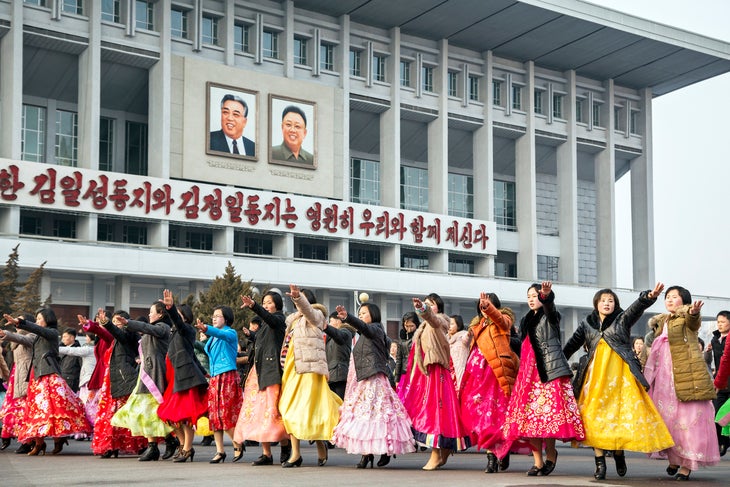
There isn’t so much eavesdropping to do. Some say fewer than 2,500 Americans have visited the country since the Korean War ended in 1953, although official numbers are impossible to come by. Up until 2010 the regime refused to allow its bloodiest enemy into the country at all save for brief visits to Pyongyang’s summer mass games, a highly choreographed display of gymnastics and dances designed to demonstrate the power of the collective over the individual. Visa rules have relaxed since then but foolish Westerners still get detained from time to time. My friend Dan Patitucci and I are fewer than a handful of American civilians ever to witness the world’s bleakest country in its bleakest month, and our reason is absurd: to be among the first people ever to ski North Korea’s first, best, newest, and only luxury ski resort.
Dan and I are spending five nights in and around Pyongyang first to get a feel for the country. When we arrive the entire nation is celebrating what would have been the 73rd birthday of Kim Jong-il with dances, synchronized-swimming shows, and garish exhibitions of giant genetically engineered begonias called kimjongilias. We must do as we’re told. We bow before statues in unison. We may not take pictures of anything “dirty” or “poor” but “only beautiful, please.” We may not even leave the Yanggakdo without a minder. Make that two minders—one to watch us and another to watch the watcher.
Back in the elevator the doors crash open into darkness again. This time the air rushes out as a herd of shriveled people rushes in. They are elderly Koreans, barely four feet high, their bodies gnarled by a lifetime of hunger, disease, and deprivation. I have no idea who they are or why they are here. They move in such a tight, protective pack that their heads bash together like livestock in a chute. Their eyes—Jesus. I can’t stop looking at their eyes. They are gray and so gooey they look like they could drip out of their skulls and stain the floor.
A foreigner is not supposed to see this. This is a glitch in the Matrix that reveals the colossal failures happening inside North Korea. When we reach the lobby everyone scurries out. The bellhop looks at them, then at us. He sees our cameras and reports us to a guide.
“You took photos,” the guide says. “No, we didn’t.” “Hmm,” he says suspiciously, but he lets us go.
North Korea’s first ski resort opened in January 2014. Created by Supreme Leader Kim Jong-un, it has 10 north-facing runs, six lifts, and 2,300 vertical feet—a bright spot among the Communist country’s prison camps, poor health care system, and lack of adequate food.
TERRIBLE THINGS CAN happen if you don’t play the game that every North Korean must play. You feign reverence and you swallow lies. You fold your newspaper gingerly to leave no creases on Kim Jong-un’s face. Mar his visage with a coffee ring and off to the gulag you go. The worst part is how you must be thankful for this misery. “We owe everything to our glorious leaders,” a North Korean flight attendant named Miss Rhee told me with zero emotion. “They love us and we love them.”
The first leader, regime founder Kim Il-sung, ruled the Democratic People’s Republic of Korea for 50 years after the Korean War killed at least two million people and left the peninsula divided into a Communist north and a capitalist south. The oldest of his four legitimate sons, Kim Jong-il, came next, in 1994. He immortalized his father by anointing him the country’s Eternal President and resetting the calendar to mark the years since Kim Il-sung’s birth and his adherence to juche, a belief in Korean self-reliance from the rest of the world.
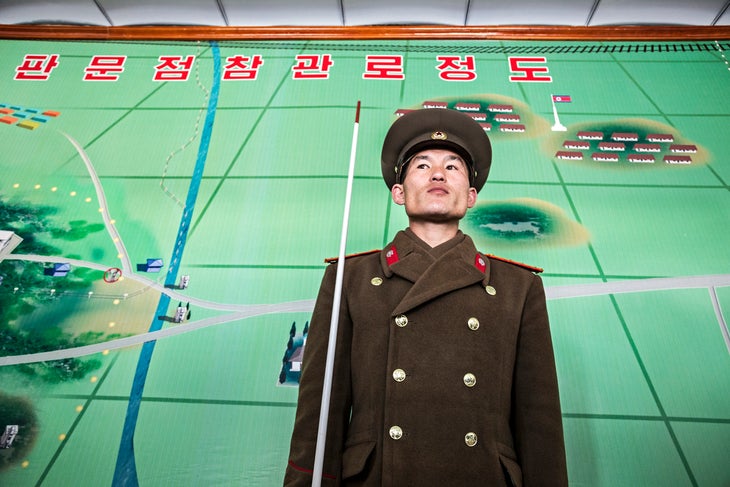
Psychologists working in conjunction with the Society for Terrorism Research would later show Kim Jong-il to be more sadistic than Saddam Hussein and Hitler. The “Highest Incarnation of the Revolutionary Comradely Love,” as he was sometimes called, kidnapped foreign movie stars and spent billions on a nuclear bomb while executing peasants for distributing rice during a famine. He died in a plush train car in 2011 and his youngest son, Kim Jong-un, took over. The boy-faced dictator was such a mystery to intelligence agencies that no one was even sure of his age. Was he 29? 30? 31? What was certain was that the oldest son and heir apparent, Kim Jong-nam, had forever fouled his chances of furthering the dynasty after Japanese authorities arrested him in 2001 for trying to slip into their country on a fake passport. It was no cloak-and-dagger mission. He was on his way to Disneyland. “These guys have never had to go around kissing babies,” says Simon Cockerell, manager of Beijing-based Koryo Tours, who has led at least 140 trips into North Korea since 1993. “They almost never speak. You never see them arriving or leaving or doing anything humans do.”
This divine-like mystique allows the Kims to be experts on everything. When he wasn’t murdering his rivals, Kim Il-sung supposedly penned operas with titles like Sea of Blood. Kim Jong-il had a “profound knowledge of poultry,” shot 11 holes-in-one on his first game of golf, and apparently never poo’d. Kim Jong-un, it turns out, is a pretty great skier.
That last bit might actually be true. Unknown to virtually everyone inside North Korea, Kim Jong-un attended private school in Bern, Switzerland, where he almost certainly went skiing. After all, that entire country takes off for a week every winter to pursue the sport, and the Alps are within easy reach of town. So far his time in power has been characterized in part by the creation of a raft of new leisure facilities. You can now slide around at a water park in Pyongyang, watch dolphins at a dolphinarium, or ride roller coasters at a place called the People’s Pleasure Ground.
“Since he’s come into power there are so many changes happening,” says Amanda Carr, a British guide who has made at least 44 trips to North Korea. “Every year more places are opening up.”
A few weeks before my visit, Kim Jong-un unveiled his greatest pleasure project yet: the $100 million Masik Ryong Ski Resort. Located in the Ryongjo Workers’ District of Kangwon Province, some 110 miles east of Pyongyang, the resort opened on New Year’s Day 2014 with 10 north-facing runs, six lifts, and 2,300 vertical feet of cold northeast Asian powder. The army’s shock-brigades had built it all in just 18 months. Bands played, people cheered. Even Kim Jong-un’s good pal Dennis Rodman was on hand, reportedly drunk and roaring around on a Ski-Doo.
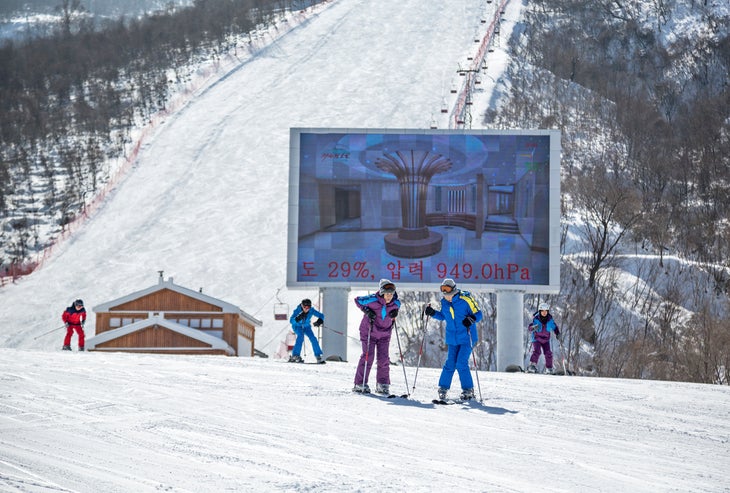
Then the portly dictator himself donned a dashing black hat and spent a few hours skiing with such perfect poise that he didn’t even need his poles. That was the rumor anyway, because no one actually saw it.
Most remarkable of all, Americans could ski there too. All I had to do was sign up with a North Korean–approved tour company and buy medical evacuation insurance. “I really have to insist that you get it,” Rich Beal, a polite Koryo Tours manager told me when we met in China. “The treatment for a compound fracture there is amputation.”
OUR FIVE DAYS OF context in and around Pyongyang creep by. Speakers blast propaganda from rooftops.
Bright red signs at intersections scream slogans like “Defending the leader at the cost of our life is our best life!” We go bowling as if nothing is wrong and visit a war museum so full of misinformation that even the East Germans ridiculed it in a 1961 memo. One day we put on ties and bow before the waxy remains of Kim Jong-il, who lies in a glass box like Lenin with his big, glorious head on a white bolster pillow. An Australian in another group gets detained for trying to distribute Christianity pamphlets, a crime against the state.
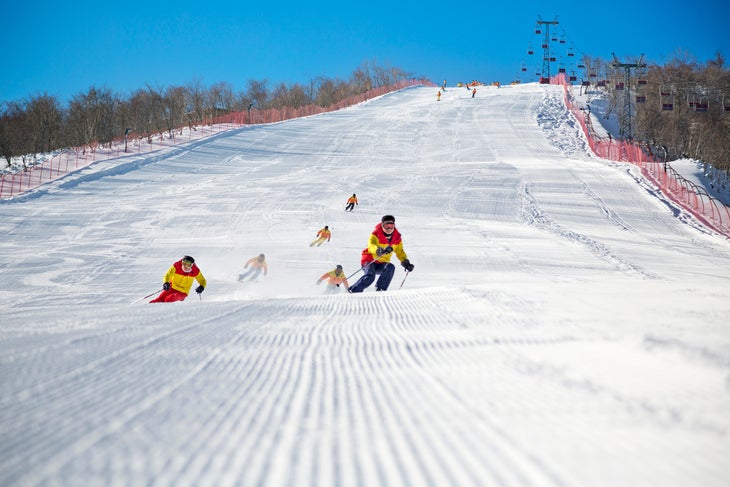
At last the skiing can begin. It’s a four-hour trip to Masik Ryong on roads long and straight enough to land military jets because military jets do land on them. The landscape is severe, indifferent, beautiful: sharp hills, frosty streams, and flat, concrete townhouses with rows of doors that look like harmonica chambers. We pass a truck that runs on wood and a soldier on a bike with a rifle bouncing in a handlebar basket. If North Korea were The Hunger Games, Pyongyang would be the Capitol: a place reserved for the elite to enjoy good food, nice clothes, and electricity. Out in the districts, the people have nothing.
Dark falls and even the stars seem too spooked to shine. Then, suddenly, Masik: The resort burns away the night like an atomic blast. Lights blaze from the top of two trapezoidal hotels, dubbed Hotel 1 and Hotel 2. Before we enter, a guard checks everyone’s permits. Inside, the lobbies twinkle with recessed spotlights and flatscreen monitors. The woodwork is elegant. The tiles sparkle under our heels. Kim Jong-un has good taste. Even the urinals have that new-urinal smell.
The whole thing is sickening, really. A United Nations report lists a prison camp not so far away, a place called Kyohwaso No. 8, where escapees say they expected to die. You can’t see it but you know it’s there.
The cognitive dissonance is so loud I make a deal with myself: See Masik for what it is, not whose it is.
The next morning a light snow falls and a dozen men with witch’s brooms line up in ranks to clear the pathways and parking lots, all of which are empty. I wander downstairs to a breakfast of pickled fern and then to the gear-rental room beneath Hotel 2. Unlike South Korea, which will host the Winter Games in 2018, North Korea has virtually no ski culture at all. I expect no line.
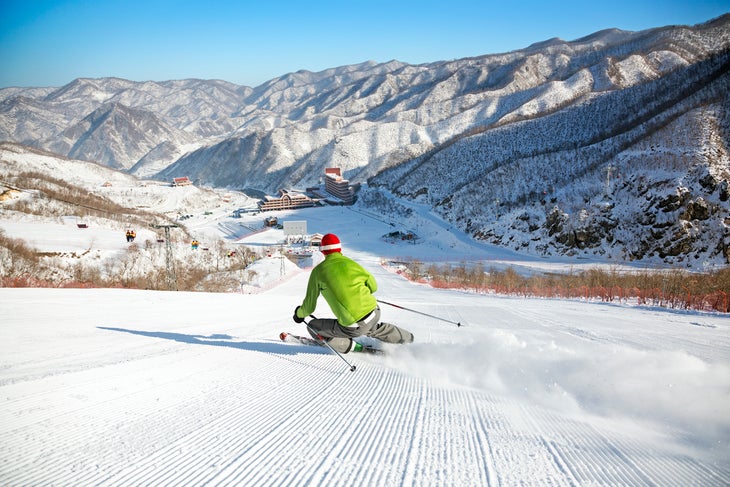
The room is packed. Scores of Koreans try on rental ski suits, rental gloves, and rental helmets and jockey for new rental skis and Italian-made ski boots. I have no idea how they can afford any of this but their excitement is unmistakable. They’re laughing, speaking loudly, and brimming with the same anticipation I feel every season. Why shouldn’t they have a little fiscally senseless joy?
Outside, 20 or so ski instructors in fluorescent orange and yellow uniforms line up for calisthenics. I get the feeling they’re military men now assigned to Masik. Behind them, a giant digital monitor blasts tinny folk tunes to images of swaying flowers, crashing waves, and the occasional missile launch.
“Hoan-young-ham-ni-da!” squawks an electronic voice, “Welcome!” in formal Korean, as Dan and I scan our passes and slip through the first lift gate. The reality of the place soon hits again.
On opening day, Kim Jong-un rode this lift without his skis. All of the lifts are slow and rickety. The foot rests hit the ground in spots and you can feel the whole cable shudder. The towers are really far apart, like the recipe called for 12 but only eight arrived. As we ascend I look down: Two workers are tightening some tower bolts with a really big wrench.
It takes 43 minutes and three rides to reach the summit of 4,468-foot Taehwa Peak, but we get there in one piece. Two lift attendants in fuzzy white hats bow and spring into action. There is no exit slope to whisk you away—just a flat landing—so Lift Attendant 1 seizes the chair from behind while Lift Attendant 2 helps me shuffle out of the way without getting bulldozed. Lift Attendant 3, the one with a finger on the emergency shutoff switch, doesn’t exist.
“Well, let’s go ski North Korea,” Dan says, and we push off down the slope.
AFTER FIVE DAYS OF constant anxiety, we are back in a familiar world of snow and gravity. The storm builds and so does a sense of camaraderie. A skier from Pyongyang poses for a picture with me. Another shakes my hand. Our guides can’t ski and have let us roam—alone. Masik’s two groomers made only one pass up the middle of Slopes 1 through 9, all of which fall back to the base, leaving 30-foot-wide sideburns of untracked snow on each side of the pistes. Kim Jong-il could allegedly control the weather with his mind but I doubt conditions were ever this good for his son. We have virgin powder all day long.
Dan and I race down Slopes 7, 8, and 9. They feel like intermediate runs but the signs don’t say. The birch trees to either side are as tight as toothpicks in a shot glass so we stick to the runs. I imagine Kim Jong-un doing lonely giant-slalom turns with the angulation of Ted Ligety. We bounce past a mid-mountain pavilion where he probably did some tricks just as his GoPro failed. We settle for views of the brown valleys below, then leapfrog each other, high-fiving our powder eights.
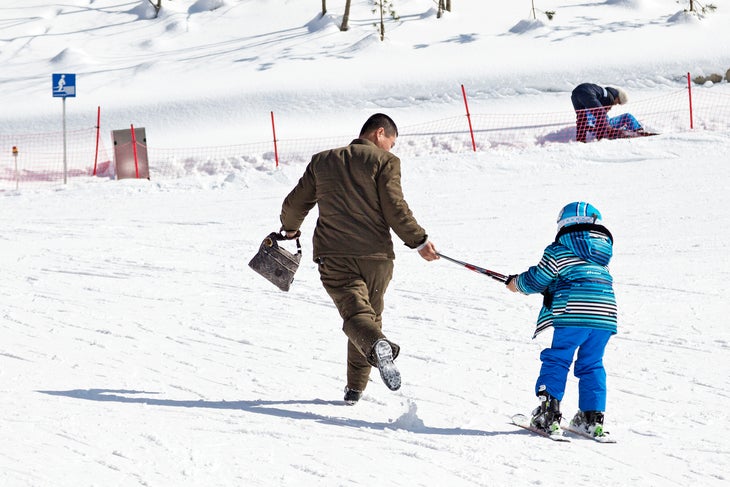
Most of the North Koreans here have never been on skis before. They stick to the bunny hill below but attack it with gusto. Some crash into an orange safety fence. Others can only go right. One lady steams toward a table-filled patio, then diverts to port with the turning radius of a cargo ship.
“I told you you would see lots of local people here,” says a guide taking lessons. “This is very new for us.”
So new, in fact, that a lot of people don’t even bother with skis. Instead they cuddle up and ride the lifts around and around, up and down, thrilled just to be there. Each time our paths cross they wave and smile as if to confirm that this is no dream. These are not the brainwashed marcher-bots we tend to envision, but lovers, maybe my wife and me, content to snuggle on a dawdling loop where “only beautiful, please” plays on repeat.
That evening I go to a karaoke bar in Hotel 1 with a few of the Westerners.The place is empty, just two Korean guys shucking a dried mackerel for a snack. The two barmaids wear maroon skirts and vests. One of them hands me a full bottle of soju, a rice spirit. The other flicks on some disco lights and together they sing sassy duets for hours to a crowd of five. They seem a bit overenthusiastic. Maybe this is the greatest job ever. Maybe they’re being watched.
Our last day dawns cold and clear, but the deal with myself collapses. I feel guilty for enjoying a place where the construction costs would have fed the hungry for years and there’s still this air of suspicion that lingers everywhere we go. The instructors ignore me when I ask to warm up with them. Dan and I do runs on Slope 4 and 5, where the crystals hiss and ricochet off my knees, but the long rides up are becoming unpleasant. There’s a camera in the trees.
By the time we leave I still have no idea who in North Korea can really ski here. Our guides say anyone but I’m skeptical. Lift tickets cost roughly $40 a day. A good job pays $10 a month. You need police permission just to leave your town, and who has any free time anyway? Fridays are manual-labor days. Saturdays are time to study ideological texts. Sundays could work—those are personal-betterment days—but unless you’re in good standing with the regime you’re probably too busy surviving.
Things are slowly changing, though. You see more cell phones, more cars, more people with watches. Some Koreans may ski for free with their work units. Ski clubs could build the ranks. We in the West can’t imagine that people in a place ruled by such darkness and death could ever find joy. But sometimes they do.
It is dark again by the time we pull into Pyongyang for one last night at the Yanggakdo. The city is quiet; we roll down Youth Street but it is empty. There’s a battered streetcar parked on the rails ahead, motionless and dark in the middle of a wide, carless road. When the minibus’s lights brush across its windows I see dozens of people pressed against the foggy glass. They don’t look sick. They don’t look scared. They’re just waiting for the lights to come on.
This article—and many more like it—is available exclusively to Outside+ members, along with a host of others benefits such as access to the Warren Miller Entertainment film archive (that’s 50-some films), ski-instruction and fitness video tutorials, pro deals and members-only industry discounts, and a print subscription to SKI. Learn more about Outside+ or join here.